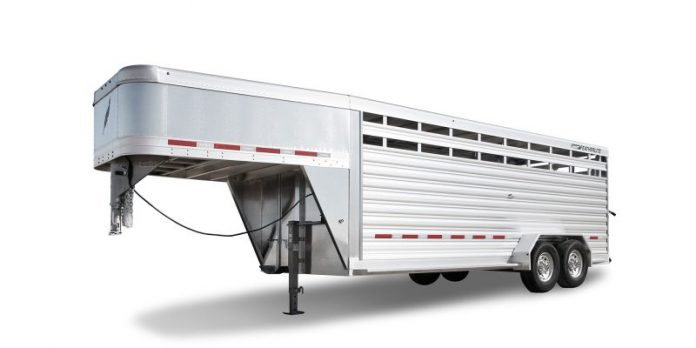Gooseneck trailers are best for those who intend to engage in significant towing. Towing a vehicle requires one to have a fundamental understanding of how to connect a trailer to a vehicle correctly. It would be very dangerous for you, your car, your load, and any other vehicles on the road if your trailer disconnected in the middle of the journey.
Numerous gooseneck trailer accidents are reported each year. When we don’t properly secure their trailers to their vehicles before getting behind the wheel, they risk endangering many other persons on the road.
If a person just latches the trailer on the truck’s ball, the trailer can become unlocked and bounce off the truck’s ball. On the other hand, if a person secures the trailer on the ball and attaches the safety chains, then the trailer will have a double hook up to the vehicle. That is why it is crucial that you hook up your gooseneck trailer the right way.
Steps to Hook Up a Gooseneck Trailer
If your vehicle already has the necessary modifications, the process of hooking up your trailer may be broken down into eight steps. It is important to note that different gooseneck trailers are available these days; however, the process of hooking up each is mostly uniform. Follow these steps to hook up your gooseneck trailer in the right way:
Step #1: Raising trailer height
To hook up your gooseneck trailer, you must start by increasing the height of your trailer. Raise the height of your trailer above that of your truck bed using the jack so that you have sufficient space to maneuver as you are backing in.
Step #2: Aligning the coupler and lowering the trailer
You will need to gently maneuver your vehicle until it is positioned below the coupler on the trailer. The hitch ball needs to be positioned to be centered beneath the coupler to the greatest extent feasible, and the truck ought to be parked in a line directly in front of the trailer.
Avoid connecting up a trailer to a ball at an angle. This makes connecting the trailer to the vehicle more difficult. At this point, the spotter may be of great assistance in letting you know when everything is aligned exactly as it should be.
Slowly lower the trailer onto the ball attached to the vehicle using the jack. As soon as you hear the coupler snap into place, move the pin on the latching mechanism down to the locked position so that the coupler may be latched into the locked position.
Step #3: Raising the jack feet and securing the jack handle
Since the trailer’s weight is now transferred to the bed of your vehicle, you should be able to raise the jack feet easily. You must place a pin above each foot. When you pull the pin, it will free the foot. Finally, you may secure the jack handle.
Step #4: Connecting the breakaway cable
You may use the clamps or hooks supplied to secure the huge safety chains to the truck, which will be attached to the trailer’s frame. The majority of big gooseneck trailers include an emergency braking mechanism that consists of a short rope that is hooked to a pin.
Step #5: Attaching the safety chains
Once the breakaway line has been attached, locate the safety chains and attach them to the u- or d-bolts in the truck’s bed. Each side of the hitch system needs to have a pair of chains attached to it.
If the truck and the trailer get separated, a pin will be pulled out, which will lock the brakes on the trailer. This will only happen if the trailer becomes removed from the vehicle. If your trailer becomes detached from the vehicle that’s pulling it, this additional safety feature will prevent it from rolling away in whatever direction it pleases.
Step #6: Closing the coupler
Before you attach any electronics, you must complete the last step in securing the trailer to the vehicle. This step involves closing the coupler. Find the coupler and the safety pin, and check to see that they are both in the closed position. This will ensure that the connection will be reliable.
Step #7: Inserting the plug into the outlet
The trailer has a plug that connects to the brake and signaling system on your vehicle. You need to make sure that this is plugged into the correct outlet. If you cannot discover the connection on the side of the truck bed, you should seek below the rear bumper instead. Many vehicle manufacturers provide an out on the side of the truck bed. After you have connected the plug, you can shut the tailgate.
Step #8: Carrying out a safety inspection
Carry out a safety check as the eighth and last step. Position yourself behind the trailer, and have a friend or colleague sit in the driver’s seat to operate the brakes, turn signals, and marker lights. If the electronics are operational, you should pull your trailer gently to verify that the connection is secure.
FAQ
Q) What should I do if the trailer is not level with the truck?
The vehicle and trailer must be on the same level. During the walkaround, if the trailer seems tilted up rather than level, there is a good chance that the back of the trailer may scrape against uneven surfaces.
In addition, the trailer’s weight could be too great for a single axle, resulting in significant tire wear. When more weight is put on an axle, also known as a tire, the axle generates more heat, which raises the risk of a blowout.
A trailer that is not level will not distribute the weight equally, which will cause the tires and axles to wear out more quickly.
Q) On what areas of a trailer should the weight of a load be distributed the most?
The 60/40 states that most weight should be directed toward the front wheel at a ratio of 60 percent. The remaining forty percent may be distributed over the trailer’s rear axle.
Make sure that the weight of the load will not cause the tongue weight of the trailer to exceed the permissible limit of 15% of the total loaded weight of the trailer.
Conclusion
A gooseneck trailer is ideal for use as a multipurpose trailer. However, you must ensure that you have the appropriate trailer class for the task at hand. The process of connecting the trailers can be really simple if you have the right guidance.










